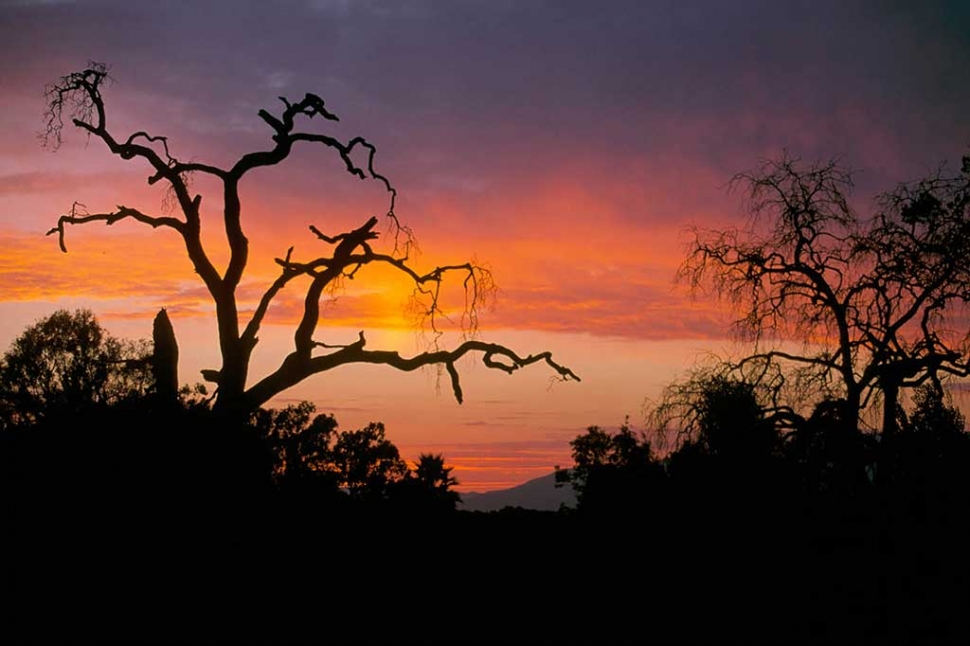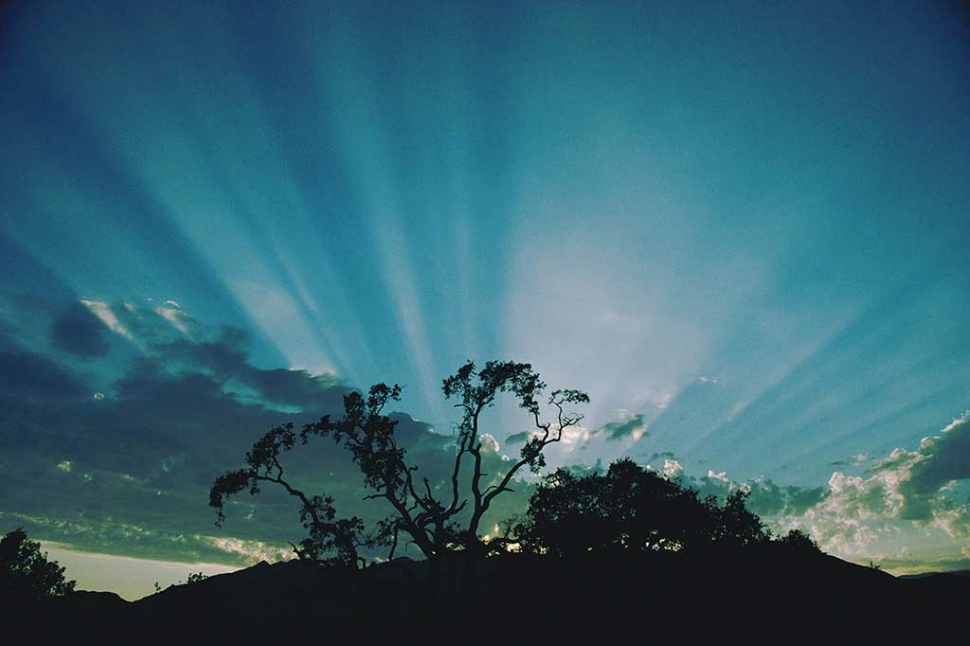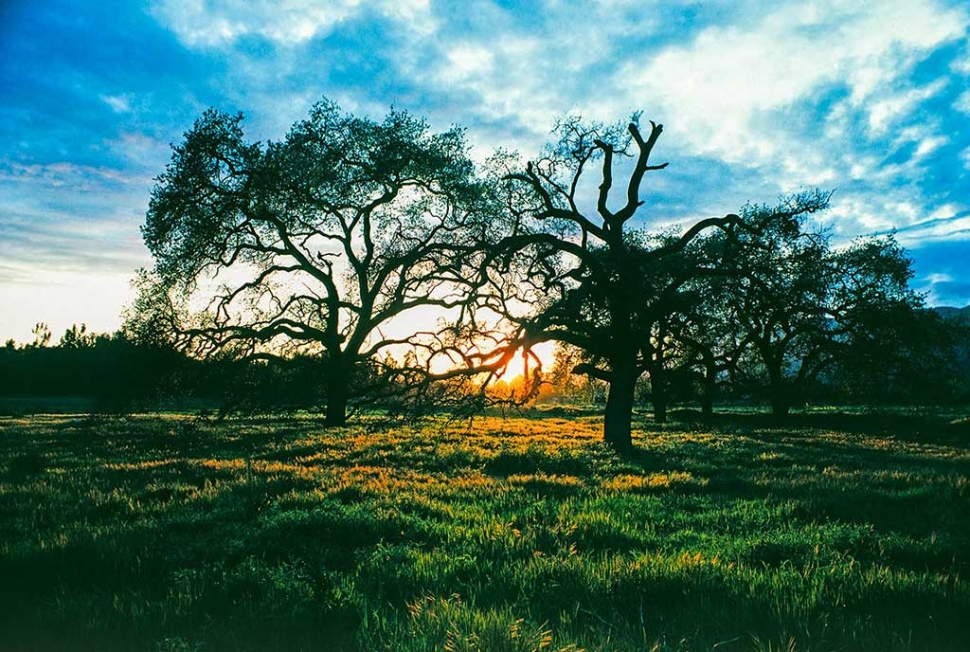|
Phil Harvey on Life and Photography
 "Horizontal Snag" by Photographer Phil Harvey By Letitia Grimes — Monday, October 5th, 2015
October 10 and 11, 2015
 "Heavenly Rays" by Photographer Phil Harvey  "Ojai Meadow" by Photographer Phil Harvey Legendary photographer Phil Harvey will open his house for the 2015 Ojai Art Detour on Saturday and Sunday, October 10 and 11, from 10:00 a.m. to 5:00 p.m. This will be the fourth year of his participation in the Art Detour, and he will be collaborating with three photographers, Myrna Cambianica, Sally Carless, and Les Dublin. On a late summer day in September, in the middle of a heat wave, Harvey sat down in his patio for an interview about his work in photography. Unfazed by the heat, or his 94 years, he spoke exuberantly about the stories behind his iconic shots of Ojai and reflected on the art of photography and of life. It was close to noon; a majestic California live oak threw dappled shade on the table, and birds were chirping contentedly. This rustic patio will be the setting where he will welcome guests on the Art Detour. With his rich baritone voice, and the lively gestures of someone half his age, Harvey sketched in the unlikely story of his introduction to photography. After a career in singing and acting, including opera and Hollywood movies, Harvey moved to Ojai in 1980. He worked as the music director for the Ojai Presbyterian Church and in 1987 founded the Ojai Community Chorus. During this time he took a job at the Ojai branch of Dexter’s Cameras. His outgoing personality made him a successful salesman, selling so many cameras that people would come back to the shop and ask for instruction and advice on how to take pictures. Harvey’s response to their needs exemplifies his community spirit. He founded the Ojai Camera Club in 1984 to help educate people in photography. Now renamed the Ojai Photography Club, it is still going strong. Taking up watercolors as a hobby, Harvey became frustrated with the limitations of the medium as he tried to capture fleeting colors of the landscapes. When a friend suggested using a photograph of the TopaTopa mountains as the model for a painting, he had a moment of deep insight that would guide his art from that point onward: “I found that I was more interested in the light of life, and when you reverse it, it’s the life of light as well - they are intertwined.”He was interested in convincing his camera to capture the light that he saw. This was the beginning of a long love affair with the“light of life”in the Ojai Valley as seen through the lens of his camera. Bringing into photography the discipline and persistence demanded by his careers in music and acting, he returned again and again to the same well-loved places.The Ojai Post Office tower, the TopaTopa range, and an ancient California valley oak, now in the Ojai Meadows Preserve, are among his most studied subjects. For fifteen years, Harvey went back to the oak, from the time that it still had green leaves to its eventual death, leaving only a bare snag. Pulling out his image of the tree’s silhouette against a brilliant red sunset, he said, “I have a story about this tree, that when it died it still kept its arms pointing to the sky –part of it is still there reaching to the sky.”The oak is in another of his signature photos, “Heavenly Rays.”This extraordinary shot involved the kind of happy accident that only a devoted photographer might experience. Harvey had been shooting avivid sunset, and when the colors had faded, he said, “I packed my camera, finished, started to go, looked up, and there were the rays – the glow of sunset had changed to distinct rays. I shot half a roll to get that image. I’ve never seen anything like that since.” Although he now has a digital camera, Harvey’s greatest images were taken with a film camera. Preferring the depth and natural quality of color film, hehas never manipulated his photos: “This is as it was –real in real time.”Explaining his approach further, Harvey drew on science and philosophy: “We’re in life, in time/space. Part of the illusion of our whole world scientifically is that what we see, what we hear, what we breathe, is not what is really there –it’s really vibration, and our whole life is vibration. But the wonderful part about this is that those images give you a vibration even though it is only an image. It has an emanation if you look at it –a certain emanation from it.But to sense that emanation, there must be composition and impact.” One of his most famous images shows the post office tower in a diffuse lavender-grey evening light with an almost full moon riding beside it. Harvey’s careful tracking of the seasonal light in the valley captured the exact moment: “To get the light correct, you need the right time of year, and in April the full moon is beside the tower. The actual night of the full moon doesn’t work because you need enough light for the tower. I had to catch the moon the day before it was full, because the next night would be fifty minutes later and too dark.”His many shots of the tower sought its essence: “My passion was for the identity of the tower in different kinds of light.” The wind chimes on the patio began to ring softly as the weather shifted to a cooling breeze. In answer to a question about his recommendations to people just starting out in photography, he replied, “First, get a good camera, and a regular lens for flowers and people, then just go out and start shooting. Don’t go in the middle of the day - after 10 or before 4 - and always look for the light. It’s not necessary to take a course - there are many good books to learn from. And come to camera club!” When asked forthe secret of his longevity, Harvey did not miss a beat before answering, in his strong baritone voice, “Joy, peace, and love of community. Devotion and love - that’s the important ingredient.”Like the oak tree in his garden, he is long-lived, sturdy, resilient, with branches reaching out to life and providing nourishment for others. Art Detour for Harvey is a part of the ongoing community involvement that has been the hallmark of his life since coming to Ojai, and he views it as a way “to meet people and show them how much fun we’re having doing this and how much we have enjoyed being not only just photographers but artists, doing things that are appealing to people who want to see color and light in different aspects. I think it’s mainly a community project where we love to meet the community, show them what we have, with decent prices.” Everyone attending Art Detour Stop 31, Fine Art Photography - Phil Harvey and Friends - will receive a free poster of an iconic image of Ojai by Harvey. For full information on Ojai Art Detour go to: http://www.ojaiartdetour.com |
